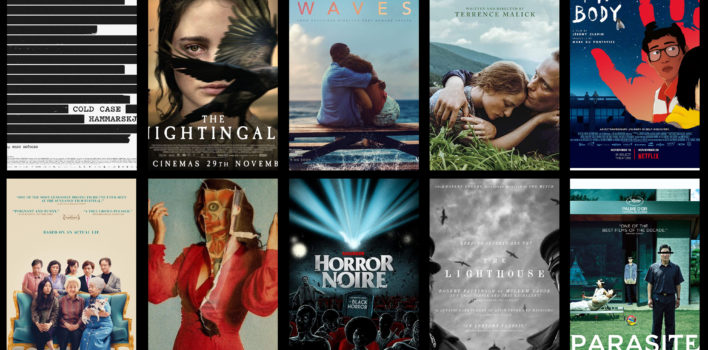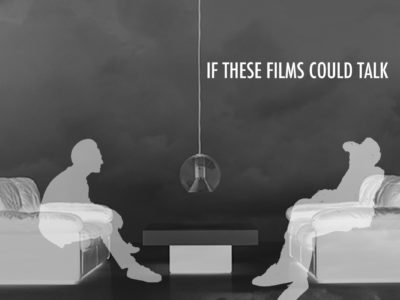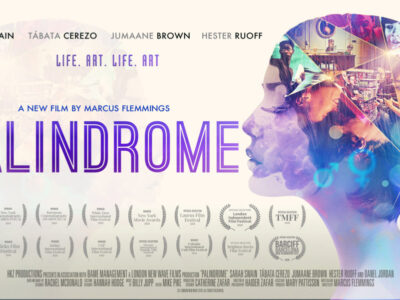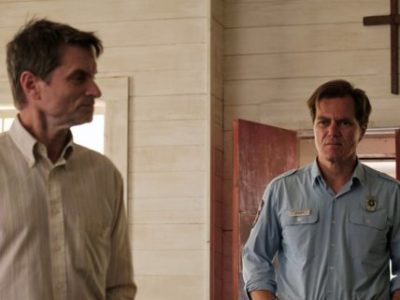My Top Ten 2019: Blake I. Collier
#10: Horror Noire: A History of Black Horror
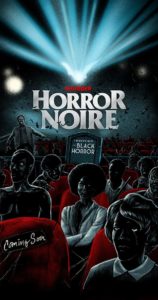 I read Robin Means Coleman’s history of African American representation in horror a few years ago so when I heard it was going to be made into a full-on documentary, I was so excited. Of all of the academic texts on horror, this may be the most important one in this day and age as it and the documentary seek to flesh out how African Americans worked through their own fears by way of horror in the midst of battling those very fears in a white-controlled studio system. The documentary, like the text, begins at the beginning of cinema and makes its way to the new century show how blacks in horror reflected their place in horror as well as manifesting a new vision for African Americans through horror. These are the types of documentaries that make me proud of and excited for the horror genre.
I read Robin Means Coleman’s history of African American representation in horror a few years ago so when I heard it was going to be made into a full-on documentary, I was so excited. Of all of the academic texts on horror, this may be the most important one in this day and age as it and the documentary seek to flesh out how African Americans worked through their own fears by way of horror in the midst of battling those very fears in a white-controlled studio system. The documentary, like the text, begins at the beginning of cinema and makes its way to the new century show how blacks in horror reflected their place in horror as well as manifesting a new vision for African Americans through horror. These are the types of documentaries that make me proud of and excited for the horror genre.
#9: I Lost My Body
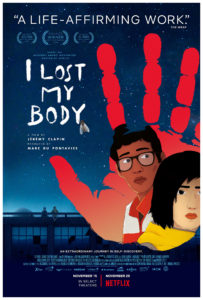 For an animated film to make it into my top ten, well, it says a lot. It means that it was able to hold my attention, that there were rich thematic depths to be mined, and there was just enough oddity to set it apart from other films, both animated and live action. We are brought into a land where a disembodied hand searches for its missing body, something that calls to mind old 50s and 60s horror films and Thing on The Addams Family. As we venture along with the hand, we see the story of a young man who goes from pizza delivery boy to apprentice for a carpenter in order to woo a girl. The two timelines merge in fascinating ways giving us great subtexts dealing with embodiment, love, and fulfillment. It’s beautifully rendered and truly unique.
For an animated film to make it into my top ten, well, it says a lot. It means that it was able to hold my attention, that there were rich thematic depths to be mined, and there was just enough oddity to set it apart from other films, both animated and live action. We are brought into a land where a disembodied hand searches for its missing body, something that calls to mind old 50s and 60s horror films and Thing on The Addams Family. As we venture along with the hand, we see the story of a young man who goes from pizza delivery boy to apprentice for a carpenter in order to woo a girl. The two timelines merge in fascinating ways giving us great subtexts dealing with embodiment, love, and fulfillment. It’s beautifully rendered and truly unique.
#8: In Fabric
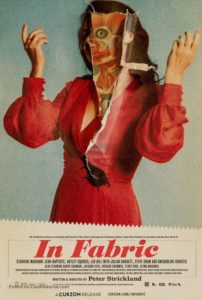 I absolutely adore Peter Strickland’s Berberian Sound Studio as it does for sound design what Italian Giallos did for color palettes. It makes sense then that his newest film would be an absurd tale of a killer dress in the style, once again, of a Giallo picture. Giallos are normally known for toying with the potential of supernatural explanations, but they seldom resolve with them. Strickland decides to set out to tie the two subgenres together in the form of a stylish red dress that gets a little too attached to its owners. It’s weird, it’s hilarious, and it accomplishes everything it set out to do. With In Fabric, Peter Strickland has become one of the most original directors in the business today.
I absolutely adore Peter Strickland’s Berberian Sound Studio as it does for sound design what Italian Giallos did for color palettes. It makes sense then that his newest film would be an absurd tale of a killer dress in the style, once again, of a Giallo picture. Giallos are normally known for toying with the potential of supernatural explanations, but they seldom resolve with them. Strickland decides to set out to tie the two subgenres together in the form of a stylish red dress that gets a little too attached to its owners. It’s weird, it’s hilarious, and it accomplishes everything it set out to do. With In Fabric, Peter Strickland has become one of the most original directors in the business today.
#7: Parasite
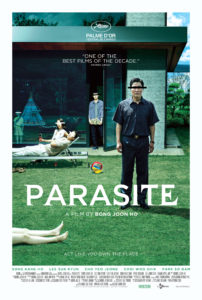 Down with Capitalism! This new Boon Jong Ho film holds all of its cards close to its chest until the final moments. Don’t worry, the ending isn’t clean cut and the film is not a puzzle box, but it does condemn something that American culture systemically denies: classism. No matter how much our bootstrap theology remains, we will always have the rich and the poor. It’s not just one middle class. And because of this, Parasite becomes the most fascinating critique of capitalist systems of economics to ever be put onto celluloid. Go into the film knowing as little as possible and I guarantee you will not guess where it will end up. Yet when its over, you’ll want to go right back in to watch again.
Down with Capitalism! This new Boon Jong Ho film holds all of its cards close to its chest until the final moments. Don’t worry, the ending isn’t clean cut and the film is not a puzzle box, but it does condemn something that American culture systemically denies: classism. No matter how much our bootstrap theology remains, we will always have the rich and the poor. It’s not just one middle class. And because of this, Parasite becomes the most fascinating critique of capitalist systems of economics to ever be put onto celluloid. Go into the film knowing as little as possible and I guarantee you will not guess where it will end up. Yet when its over, you’ll want to go right back in to watch again.
#6: The Lighthouse
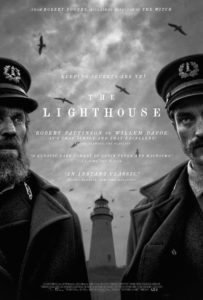 It brought wickies back into fashion. This follow-up to The VVitch from Robert Eggers doubles down on the period accuracies in language, clothing, the look of the lighthouse (which Eggers built), and the 4:3 black and white frame size. However, much like the former film, this is an exercise in the slow burn style of horror. Unlike the former, this film is surprisingly lively and funny with two delightful and unhinged performances from Robert Pattinson and Willem Dafoe. The Lighthouse has stuck in my mind much longer than The VVitch did even though Eggers has proved himself to be a truly one-of-a-kind, DIY auteur.
It brought wickies back into fashion. This follow-up to The VVitch from Robert Eggers doubles down on the period accuracies in language, clothing, the look of the lighthouse (which Eggers built), and the 4:3 black and white frame size. However, much like the former film, this is an exercise in the slow burn style of horror. Unlike the former, this film is surprisingly lively and funny with two delightful and unhinged performances from Robert Pattinson and Willem Dafoe. The Lighthouse has stuck in my mind much longer than The VVitch did even though Eggers has proved himself to be a truly one-of-a-kind, DIY auteur.
#5: The Nightingale
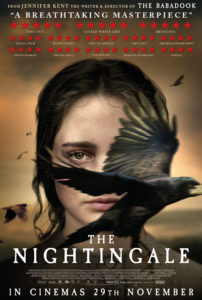 If you can make it through the first thirty minutes of the film where most of the harshest elements reside, you’ll be treated to a deeply moving and beautiful reflection on colonialism, race, gender, violence, redemption and the music that can stir our souls. Jennifer Kent’s last film, The Babadook, heralded the beginning of that misguided moniker, “elevated horror.” While it remains a solid horror about grief, The Nightingale shows Kent’s teeth and her aesthetic prowess. She is more than a one hit wonder and the performances she is able to get out of her actors is sublime. It’s a rough film, a grimy film, but rewards those viewers who stick around until the end.
If you can make it through the first thirty minutes of the film where most of the harshest elements reside, you’ll be treated to a deeply moving and beautiful reflection on colonialism, race, gender, violence, redemption and the music that can stir our souls. Jennifer Kent’s last film, The Babadook, heralded the beginning of that misguided moniker, “elevated horror.” While it remains a solid horror about grief, The Nightingale shows Kent’s teeth and her aesthetic prowess. She is more than a one hit wonder and the performances she is able to get out of her actors is sublime. It’s a rough film, a grimy film, but rewards those viewers who stick around until the end.
#4: Waves
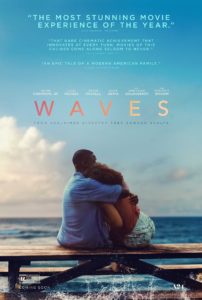 I admit it. I sobbed during the final quarter of this film. Trey Edward Shultz has an uncanny ability of tearing families apart only to find the strength that remains in the broken places of their lives. It would be easy for a white director to make a safe film about a black family, but it’s harder for a white director to make a film about a real black family with all of the dynamics present in every American family and those present specifically in the black communities of nation. It’s a film full of grace and ends up indicting American society for the generational sins it continues to perpetuate.
I admit it. I sobbed during the final quarter of this film. Trey Edward Shultz has an uncanny ability of tearing families apart only to find the strength that remains in the broken places of their lives. It would be easy for a white director to make a safe film about a black family, but it’s harder for a white director to make a film about a real black family with all of the dynamics present in every American family and those present specifically in the black communities of nation. It’s a film full of grace and ends up indicting American society for the generational sins it continues to perpetuate.
#3: A Hidden Life
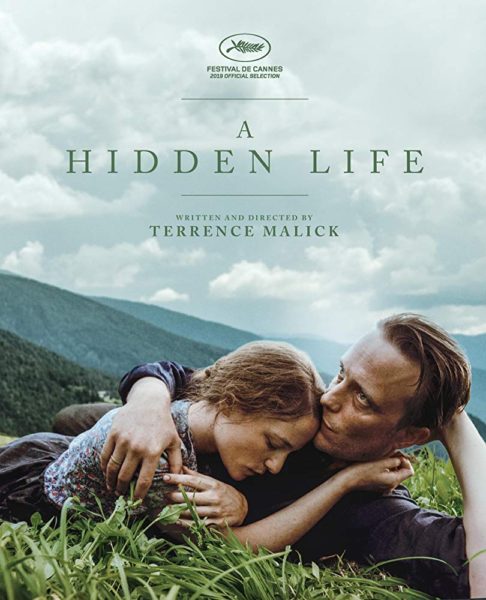 What is it to be moved by the Spirit in such a way as to push back against a force that will inevitably crush you? Terrence Malick uses his unique cinematic style to explore the courage and good that pervades this world yet is hidden beneath the glories of history. Franz Jägerstätter is a conscientious objector who refuses to fight for the Nazis only to be imprisoned and killed. However, Malick’s film, ultimately, is a meditation on faithfulness and a Spirit-filled life where to lose one’s life is to gain it.
What is it to be moved by the Spirit in such a way as to push back against a force that will inevitably crush you? Terrence Malick uses his unique cinematic style to explore the courage and good that pervades this world yet is hidden beneath the glories of history. Franz Jägerstätter is a conscientious objector who refuses to fight for the Nazis only to be imprisoned and killed. However, Malick’s film, ultimately, is a meditation on faithfulness and a Spirit-filled life where to lose one’s life is to gain it.
#2: Cold Case Hammarskjöld
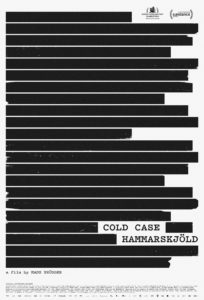 What happens when the story you are trying to break wide open crumbles only to reveal a more significant, wider-reaching, and potentially more devastating conspiracy that lies behind it all? Mads Brügger digs into the strange death of Dag Hammarskjöld, UN Secretary-General, and finds himself embroiled in an even bigger tale that is either truly sinister or the greatest message-board conspiracy ever concocted. Regardless of where the truth lies, this documentary has themes that will resonate in the age of “truthiness.”
What happens when the story you are trying to break wide open crumbles only to reveal a more significant, wider-reaching, and potentially more devastating conspiracy that lies behind it all? Mads Brügger digs into the strange death of Dag Hammarskjöld, UN Secretary-General, and finds himself embroiled in an even bigger tale that is either truly sinister or the greatest message-board conspiracy ever concocted. Regardless of where the truth lies, this documentary has themes that will resonate in the age of “truthiness.”
#1: The Farewell
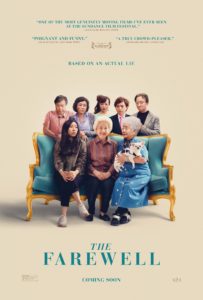 Lulu Wang’s ability to wring laughter and tears from her audience as she takes us through the story of her family’s “true lie” is a balm for my weary soul after losing my own grandmother to cancer last year. The film’s exploration of East/West juxtapositions of grieving is both profound and cathartic for anyone who knows the dread of being on the precipice of losing someone you so deeply love. No other film had a chance at the number one spot.
Lulu Wang’s ability to wring laughter and tears from her audience as she takes us through the story of her family’s “true lie” is a balm for my weary soul after losing my own grandmother to cancer last year. The film’s exploration of East/West juxtapositions of grieving is both profound and cathartic for anyone who knows the dread of being on the precipice of losing someone you so deeply love. No other film had a chance at the number one spot.
• •
Honorable Mentions:
A Beautiful Day in the Neighborhood
Monos
The Man Who Killed Hitler and Then the Bigfoot
The Mustang
Us


